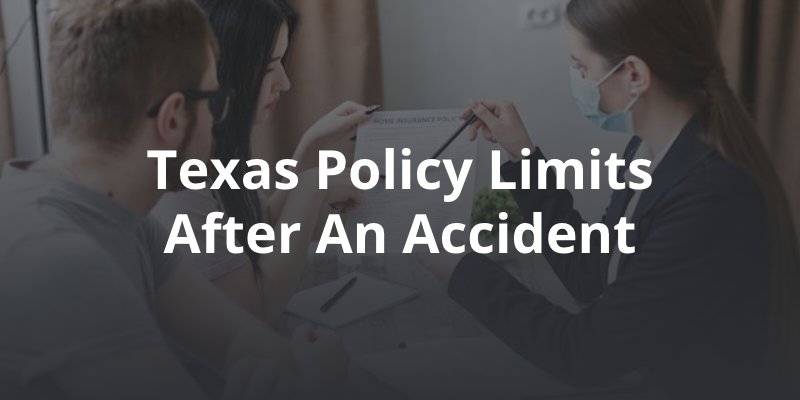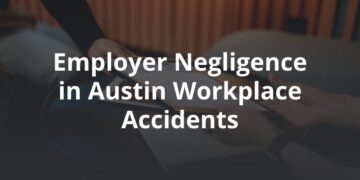
If you have been in an accident that wasn’t your fault, the law allows you to collect damages from the at-fault party, including compensation for your medical costs, lost wages, quality of life losses, and property damage.
Unfortunately, sometimes the amount of money you should be allowed for your losses exceeds the amount of insurance coverage available to pay for those losses, including your own underinsured motorist coverage.
To understand how often auto accidents exceed the policy limits, it is important to understand the basics of insurance policy limits and the laws surrounding them.
While it is possible to collect personal injury damages beyond the limits of the defendant’s insurance policy in very limited cases, it’s not easy, and you will need the assistance of a personal injury lawyer in Austin to help you through the process. Here is what you need to know about insurance policy limits after your accident.
Understanding Policy Limits
When an individual purchases liability insurance, it always comes with a policy limit, which refers to the maximum amount of money that the insurance company will pay on behalf of that person for the damage they caused.
This holds true not only for regular automobile accidents but also for accidents involving commercial vehicles, such as trucks. Commercial truck accidents often result in more severe damages and injuries due to the size and weight of these vehicles. If you’re involved in a truck accident in Austin, understanding the policy limits becomes crucial. Seeking guidance from an experienced Austin truck accident lawyer is essential to ensure you receive the compensation you deserve.
Types of Automobile Insurance Policy Limits
In Texas, all motor vehicle drivers must purchase minimum amounts of liability insurance to pay for harm and damage caused to others in an at-fault car accident. The state has laws in place for how much liability insurance must be maintained by a motor vehicle operator to comply with the insurance rules.
After a car accident takes place, you should have access to the following amounts of coverage from another driver’s car insurance policy if he or she was at fault:
- Bodily injury insurance: covers injuries caused to others, including necessary medical expenses and lost wages. The limits are split 30/60, meaning drivers are required to carry at least $30,000 worth of coverage per person and $60,000 per accident for bodily injuries.
- Property damage insurance: pays to repair the other driver’s damaged vehicle, or to replace it if the vehicle is deemed a “total loss,” meaning the price to repair it exceeds the total value of the car. Texas law requires at least $25,000 in property damage car insurance coverage.
- Uninsured/underinsured motorist: although not a legally required type of insurance in Texas, this coverage will automatically be applied to a new policy and must be rejected in writing. A driver can typically add this insurance to a policy in $5,000 increments.
Note that these are only the minimum amounts of required coverage in Texas. A driver may choose to purchase additional coverage in higher amounts, if desired. In addition, you may have coverage on your own policy that you can access if your losses exceed the other driver’s policy limits, such as collision or comprehensive insurance.
Finally, these are only the limits for car insurance – other types of insurance may apply if you’re injured in a different kind of accident. Property insurance can cover your losses after a slip and fall accident, for example. Speaking to a knowledgeable attorney can help you understand the policy limits that apply to your specific case.
Exceeding Policy Limits
When accidents happen, victims often wonder how often auto accident settlements exceed the policy limits. While it’s somewhat rare, it does happen, so it’s important to understand the process.
For example, if you were involved in a car accident in Austin and the at-fault driver’s insurance has a policy limit of $50,000 for bodily injury, that is the maximum amount that the insurer is legally obligated to cover for your harms and losses — even if your medical costs, lost wages, quality of life losses, and other expenses exceed that amount.
This is usually true even if you are awarded more than the policy limits by a judge or jury in court. So is it possible to collect excess damages? And if so, who pays? Consulting with an experienced Austin car accident lawyer can provide you with the guidance and support you need to navigate the complexities of policy limits and ensure you receive the compensation you deserve after a car accident.
Factors That Can Affect Settlements
Whether or not your claim will exceed policy limits depends on its value, meaning how much your personal injury lawyer believes it’s worth. Case values in Texas can vary a lot based on the unique aspects of each case.
Factors that could affect your settlement value include:
- Injury severity
- The amount of disability, if any
- The costs of medical treatments (past and future)
- Lost wages and lost ability to earn in the future
- The amount of pain and suffering caused by the injury
- Comparative fault (whether you are found partially at fault)
Insurance policy limits play a role in determining how much financial compensation you can collect for your injuries. If the at-fault party has low insurance limits, this can cap how much you can recover. However, it may be possible to collect excess damages with help from an experienced lawyer.
Can You Collect Excess Damages?
The short answer is yes, it is possible to collect more than the at-fault driver’s insurance policy limits. However, if you are going to pursue this route, you should know that it is unlikely, and proceed with the assistance of a personal injury lawyer.
The four ways you can collect damages in excess of the at-fault driver’s insurance policy limits are:
- Filing suit against additional defendants
- Collecting under an umbrella policy
- Collecting from the defendant
- If an insurance company acts negligently under the Stowers doctrine
Of course, if you have your own underinsured motorist coverage policy that protects you in the event of bodily injury, you can collect from your own policy. But this article should help you understand the ways you can try to collect more from the at-fault driver than their insurance policy allows.
Filing Suit Against Additional Defendants
In some instances, more than one party can be considered legally and financially responsible for an accident.
For example, if you were in a car accident and the at-fault driver was driving on behalf of an employer, you have the option to sue the employer, as outlined by the legal doctrine of respondeat superior, which states that employers can be held responsible for the negligent acts of their employees while acting in the course and scope of their business.
If other drivers were involved in the accident, you can also file a claim against each party, since they will all be responsible for a percentage of your medical costs based on the percentage of fault they are legally assigned.
And, in some instances, you can prove that multiple defendants — such as businesses engaged in a joint venture — were acting in concert together. If so, the defendants who were acting together can all be held accountable for your losses.
Collecting Under an Umbrella Policy
Even if there is only one at-fault party in your case, there may still be more than one insurance company or policy involved that can pay out the excess damages. An umbrella policy is a type of insurance that adds extra liability coverage over and above — much like an umbrella — the primary insurance.
The umbrella policy kicks in when the at-fault party faces liability for damages that exceed the specified policy amount of the underlying policy. Umbrella policies are most common for people who have assets they want to protect by making sure they have enough insurance coverage.
Collecting From the Defendant
In most cases, however, there is no umbrella policy and no employers or other defendants who may be liable to contribute to a settlement. If you find yourself in this situation, as many people do, and your harms and losses exceed the insurance policy limits, the only option left is to try to collect from the defendant personally.
While many defendants do not have any assets worthy of collecting, or only have assets that are exempt from collection under Texas law, a personal injury lawyer can help search for assets that might be used to satisfy a judgment against the defendant.
If assets are located, such as real property, cash, shares of stock, mineral rights, or vehicles, the lawyer can start the process of recovering those assets from the defendant. Unfortunately, most defendants that are poorly insured do not have any assets of value. This is why it is always prudent to purchase as much underinsured motorist coverage for bodily injury as you can afford.
Insurance Company Acting Negligently
The final option for pursuing a settlement that exceeds policy limits is if the insurance company has acted negligently towards the at-fault driver, leaving them exposed to a large judgment. This is commonly called the Stowers doctrine in Texas, after the landmark Texas court case that established the principle.
If you are willing to settle your claim against the at-fault driver for an amount of money within their insurance policy limits, and the defendant’s insurer negligently fails to do so, and you then you secure a jury verdict in excess of those policy limits, the insurance company could be liable for the full amount of damages awarded in that jury verdict, even if it exceeds the policy limits. But the law in Texas continues to make true Stowers doctrine claims more and more rare, by making it more difficult than ever to prove that an insurance company was negligent.
For example, if you do not have a strong case and your settlement demands were unreasonable, the insurance company is not likely to be found negligent if it refuses to settle. Or, if the demand for settlement does not provide sufficient clarity about the amount and extent of losses, and supporting documentation about why the at-fault driver is negligent, the insurance company will probably not face sufficient pressure to invoke the Stowers doctrine.
How Can FVF Law Firm Help?
At FVF Law Firm, our goal is to get to know you and to provide you with the information you need to make the best decisions for yourself after a serious accident. We understand how insurance companies work and how to navigate policy limits for our clients.
We can thoroughly investigate your case to identify all potential sources of financial compensation – seeking the payout that you need to become whole again. We’ve collected millions of dollars in compensation for deserving accident victims by seeking recoveries beyond insurance policy limits.
Our Austin car accident lawyers have more than 100 years of experience successfully handling many different types of personal injury accidents. We will develop a personalized strategy to ensure that you receive an outstanding result for your case, either through insurance settlement negotiations or a personal injury lawsuit in Texas.If you’ve been injured in an accident, you may be entitled to compensation for your medical bills, lost wages, and changes in your quality of life. FVF Law Firm – Injury & Wrongful Death Lawyers can help you understand your rights and receive the fair compensation the law allows. Contact us for a free consultation to discuss your accident, develop a settlement plan, and get started on your road to recovery.







